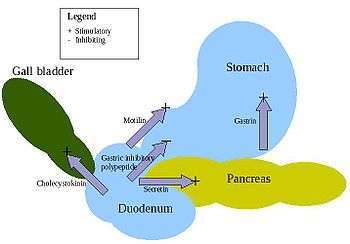APUD cell

Actions of the major digestive hormones secreted by APUD cells
APUD cells constitute a group of apparently unrelated endocrine cells, which were named by the scientist A.G.E. Pearse, who developed the APUD concept in the early 1960s. These cells share the common function of secreting a low molecular weight polypeptide hormone. There are several different types which secrete the hormones secretin, cholecystokinin and several others. The name is derived from an acronym, referring to the following:[1][2]
- Amine Precursor Uptake - for high uptake of amine precursors including 5-hydroxytryptophan (5-HTP) and dihydroxyphenylalanine (DOPA).[2]
- Decarboxylase - for high content of the enzyme amino acid decarboxylase (for conversion of precursors to amines).
See also
References
- ↑ Welbourn RB (January 1977). "Current status of the apudomas". Ann. Surg. 185 (1): 1–12. doi:10.1097/00000658-197701000-00001. PMC 1396259
 . PMID 12724.
. PMID 12724. - 1 2 Pearse, A.G. (1969). "The cytochemistry and ultrastructure of polypeptide hormone-producing cells of the APUD series and the embryologic, physiologic and pathologic implications of the concept". J. Histochem. Cytochem. 17 (5): 303–13. doi:10.1177/17.5.303. PMID 4143745.
External links
- -328531944 at GPnotebook
- APUD Cells at the US National Library of Medicine Medical Subject Headings (MeSH)
This article is issued from Wikipedia - version of the 8/21/2016. The text is available under the Creative Commons Attribution/Share Alike but additional terms may apply for the media files.